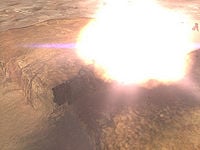Fusion drive: Difference between revisions
From Halopedia, the Halo wiki
PatrickRus (talk | contribs) |
(Right, because the Forerunners are so advanced they use deuterium fusion. The Forerunner engine in question is obviously the slipspace drive, not the STL one.) |
||
| Line 23: | Line 23: | ||
===XR2 Boglin Fields: S81/X-DFR=== | ===XR2 Boglin Fields: S81/X-DFR=== | ||
The S81/X-DFR is an advanced type of fusion engine used on the prototype warship {{UNSCShip|Infinity}} | The S81/X-DFR is an advanced type of fusion engine used on the prototype warship {{UNSCShip|Infinity}}.<ref name="bulletin101012"/> | ||
==Use as improvised weapons== | ==Use as improvised weapons== | ||
Revision as of 00:36, December 12, 2013
The fusion drive,[1] also known as a fusion engine,[2][3] and more formally referred to as a deuterium fusion reactor,[4] is a type of spacecraft propulsion system which serves as the primary form of sublight propulsion on human spacecraft, whereas the Shaw-Fujikawa Translight Engine is used for travel at superluminal, or faster-than-light, speeds. In addition to the fusion-powered main drives, human ships utilize smaller rocket thrusters using triamino hydrazine as propellant for small-scale maneuvering.[5]
Description
The primary component of a fusion drive is a fusion reactor or a series of reactors. The plasma generated by the reactors is channeled into a series of exhaust manifolds, which vector it into the ship's engine nozzles. The drive exhaust serves as reaction mass, providing propulsion for the ship. The main components of the fusion drive are typically located in a ship's engineering.[2] As suggested by its technical name,[4] the deuterium fusion reactor is powered by nuclear fusion reactions between deuterium atoms.[6]
The number of fusion engines varies between ship classes. UNSC frigates are typically equipped with two primary reactors[7] and at least another two secondary reactors,[6] while Halcyon-class light cruisers are powered by an array of three fusion reactors.[8] Larger ships, such as the mobile hospital UNSC Hopeful, could possess as many as six reactors.[9] The number of engine exhausts also varies greatly; ships usually have two or more primary adjacent exhaust nozzles, and a series of smaller, secondary ones.
Fusion engines are capable of producing remarkable acceleration; using gravity-assist maneuvers to an advantage, human ships - from small diplomatic shuttles to Halcyon-class cruisers - are capable of crossing interplanetary distances in less than an hour.[10][11]
Development history
Significant developments were made in fusion engine technology over the course of the 26th century; the Mark II Hanley-Messer fusion engines used by Halcyon-class cruisers produced only a tenth of the power output of modern reactors as of 2552.[12]
In 2552, the UNSC Pillar of Autumn was refit with a power plant which used an experimental architecture where a single main reactor was nestled within two smaller reactor rings. When activated, the secondary reactors supercharged the main reactor, and their overlapping magnetic fields could temporarily boost the reactor output by 300 percent. In addition, the engine did not require external coolant systems like most reactors, instead neutralizing waste heat by means of a "laser-induced optical slurry of ions chilled to near-absolute zero". The more power the reactor was generating, the more supercooled particles it produced, effectively cooling itself.[13]
Known models
Mark II Hanley-Messer DFR
The Mark II Hanley-Messer DFR is a type of deuterium fusion power plant used on Halcyon-class light cruisers, which are typically equipped with three of the reactors.[14] They were obsolete by 2552, providing only a tenth of the power generated by modern reactors at the time.[12]
Naoto Technologies: V4/L-DFR
Manufactured by Naoto Technologies, the V4/L-DFR is a deuterium fusion drive equipped on Charon-class light frigates, such as the UNSC Forward Unto Dawn.[4]
XR2 Boglin Fields: S81/X-DFR
The S81/X-DFR is an advanced type of fusion engine used on the prototype warship UNSC Infinity.[4]
Use as improvised weapons
Fusion drives can also be used as improvised weapons of mass destruction. A ship's captain possesses the codes necessary to initiate fusion core overload in their command neural interface, but reactor destabilization can also be initiated manually. Though the fusion reactors are protected by magnetic containment fields which surround the fusion cells, they can be destabilized by explosive ordnance once the exhaust couplings protecting the reactor vents have been retracted. Significant amount of damage to the engines will trigger a "wildcat destabilization". The reactor will then detonate within minutes, generating a temperature of over 100,000,000 degrees. The most notable instance of this was when John-117 destroyed Installation 04 by overloading the fusion reactors of the Pillar of Autumn.[2]
List of appearances
- Halo: Combat Evolved
- Halo: The Fall of Reach (First appearance)
- Halo: The Flood
- Halo: First Strike
- Halo 2
- Halo: Ghosts of Onyx
- Halo 3
- Halo: Contact Harvest
- Halo: The Cole Protocol
- Halo Wars Genesis
- Halo Wars
- Halo 3: ODST
- Halo: Evolutions - Essential Tales of the Halo Universe
- Halo: Helljumper
- Halo: Blood Line
- Halo: Reach
- Halo: Fall of Reach
- Halo: Glasslands
- Halo: The Thursday War
- The Commissioning
- Halo 4: Forward Unto Dawn
- Halo 4
Sources
- ^ Halo: The Fall of Reach, page 16
- ^ a b c Halo: Combat Evolved, campaign level The Maw
- ^ Halo: The Flood, page 33
- ^ a b c d Waypoint: The Halo Bulletin: 10.10.12
- ^ Halo: Contact Harvest, page 25
- ^ a b Halo: First Strike, page 275
- ^ Halo 2, campaign level Delta Halo ("Both engine cores have spun to zero.")
- ^ Halo Waypoint: Data Drop 5
- ^ Halo: Ghosts of Onyx, page 97
- ^ Halo: The Fall of Reach, pages 324-329
- ^ Halo: The Fall of Reach, page 17
- ^ a b Halo: The Fall of Reach, page 238
- ^ Halo: The Fall of Reach, page 274
- ^ Halo Waypoint: Data Drop 5
